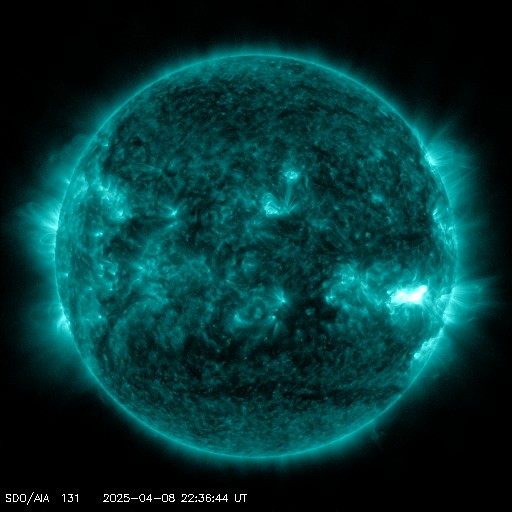Viewing archive of Wednesday, 5 March 2014
Daily bulletin on solar and geomagnetic activity from the SIDC
Issued: 2014 Mar 05 1238 UTC
SIDC Forecast
Solar flares
Eruptive (C-class flares expected, probability >=50%)
Geomagnetism
Quiet (A<20 and K<4)
Solar protons
Quiet
| 10cm flux | Ap | |
|---|---|---|
| 05 Mar 2014 | 159 | 005 |
| 06 Mar 2014 | 160 | 007 |
| 07 Mar 2014 | 161 | 005 |
Bulletin
There are currently 12 sunspot regions on the visible solar disk, with small delta's observed in the trailing portion of NOAA 1991. It was also here that the strongest event of the past 24 hours took place: an impulsive M1-flare peaking at 02:10UT. Two C-flares were produced by NOAA 1986 from behind the west limb, while three C-flares took place in NOAA 1991. Several CMEs were observed. The ones having a (partial) halo, which were first visible in LASCO/C2 at resp. 18:48UT and 21:17UT on 4 March, and 09:24UT on 5 March, were all backside events. None of the observed CMEs has an Earth-directed component, including the CME associated to a filament eruption near the northeast limb (+/- 21:00UT on 4 March). Eruptive flaring conditions are expected, with a small chance for an M-class flare from NOAA 1991. Solar wind speed has gradually increased to values between 400-450 km/s, with Bz varying between -5nT and +5nT. A coronal hole on the northern hemisphere has reached the central meridian and might produce active geomagnetic conditions from 8 March onwards. Geomagnetic conditions have been quiet and are expected to remain so.
Today's estimated international sunspot number (ISN): 120, based on 14 stations.Solar indices for 04 Mar 2014
| Wolf number Catania | 153 |
| 10cm solar flux | 158 |
| AK Chambon La Forêt | /// |
| AK Wingst | 008 |
| Estimated Ap | 007 |
| Estimated international sunspot number | 102 - Based on 17 stations |
Noticeable events summary
| Day | Begin | Max | End | Loc | Strength | OP | 10cm | Catania/NOAA | Radio burst types |
|---|---|---|---|---|---|---|---|---|---|
| 05 | 0206 | 0210 | 0212 | ---- | M1.0 | 58/1991 | III/3 |
Provided by the Solar Influences Data analysis Center© - SIDC - Processed by SpaceWeatherLive
All times in UTC
Current data suggests there is a moderate possibility for aurora to appear at the following high latitude regions in the near future
Rovaniemi, SodankyläCurrent data suggests there is a slight possibility for aurora to appear at the following high latitude regions in the near future
Oulu, KuopioArkhangelsk, Vorkuta
Luleå, Sundsvall, Umeå
Current data suggests there is a slight possibility for aurora to appear at the following middle latitude regions in the near future
TamperePetrozavodsk
Latest news
Latest forum messages
Support SpaceWeatherLive.com!
A lot of people come to SpaceWeatherLive to follow the Sun's activity or if there is aurora to be seen, but with more traffic comes higher server costs. Consider a donation if you enjoy SpaceWeatherLive so we can keep the website online!

Latest alerts
01:45 UTC - Geomagnetic activity
Active geomagnetic conditions (Kp4) Threshold Reached: 01:41 UTC
Wednesday, 9 April 2025
08:12 UTC - Hemispheric Power Index
The OVATION model predicts the Hemispheric Power Index to reach 76GW at 08:57 UTC
02:00 UTC - Geomagnetic activity
Minor G1 geomagnetic storm (Kp5) Threshold Reached: 01:45 UTC
Tuesday, 8 April 2025
23:57 UTC - Hemispheric Power Index
The OVATION model predicts the Hemispheric Power Index to reach 50GW at 00:44 UTC
22:42 UTC - Solar flare
Moderate M1.57 flare
Space weather facts
| Last X-flare | 2025/03/28 | X1.1 |
| Last M-flare | 2025/04/08 | M1.5 |
| Last geomagnetic storm | 2025/04/06 | Kp5 (G1) |
| Spotless days | |
|---|---|
| Last spotless day | 2022/06/08 |
| Monthly mean Sunspot Number | |
|---|---|
| March 2025 | 134.2 -20.4 |
| April 2025 | 144.7 +10.5 |
| Last 30 days | 138.4 +2.2 |





